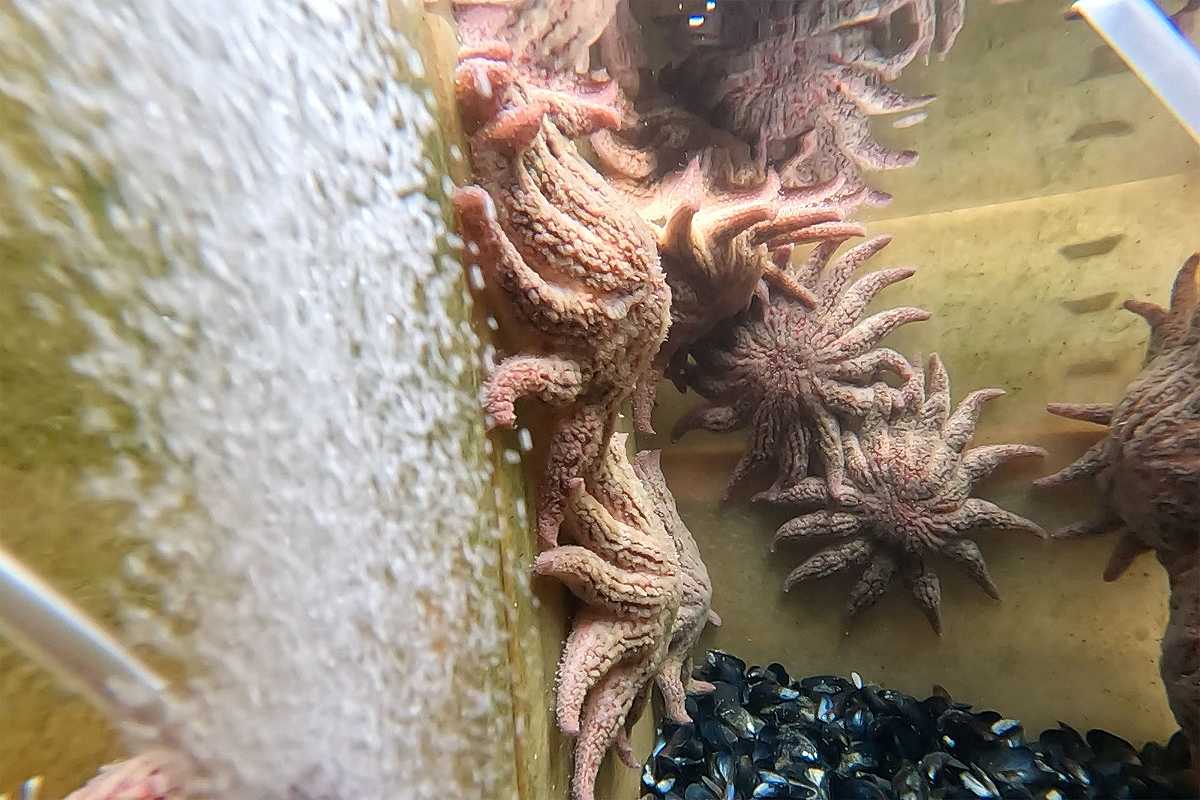
Sunflower sea stars are seen in an enclosure at the University of Washington’s Friday Harbor Marine Lab in Friday Harbor, Wash., on Feb. 11.
14:13 JST, March 8, 2023
FRIDAY HARBOR, Wash. (Reuters) — A few hours from Seattle at a location that can only be reached by boat, marine scientists at the University of Washington’s Friday Harbor lab are breeding and studying endangered sunflower sea stars following a massive die-off over the past decade.
These creatures, once plentiful along the Pacific coastline from Mexico’s Baja California peninsula to Alaska, have been decimated. Approximately 90% of them have disappeared since 2013 due to a mysterious sea-star wasting syndrome that may have been caused by climate change and the warming ocean temperatures.
“There’s some indication that disease might have been related to some warmer waters around that time,” said Friday Harbor Marine Lab Senior Research Scientist Jason Hodin, explaining the mysterious coincidence behind the death of sea stars from the disease and the prospect that climate change may have played a role.
The lab, located on San Juan Island, currently plays host to 109 1-year-old, 23 2-year-old, 12 3-year-old, and approximately 5,000 larvae sunflower sea stars in total that have been bred in captivity.
The scientists have also brought 16 adult sunflower sea stars from the wild into their lab, but it’s more difficult to discern their age. “We are now running the world’s only captive breeding program for the world’s only endangered sea star,” said Hodin, who has been at the helm of the program since its inception in 2019 and hopes to someday release them into the wild.
The university and grant-funded field station in the northern waters of Puget Sound have undertaken the new study in collaboration with the college’s neuroscience’s department, to determine if echinoderms are being affected by warming waters.
University of Washington neuroscience graduate student William Weertman, who previously worked with octopi, has taken on the task of working with the baby sea stars.
While Weertman studies the sea stars’ behavior, he uses four cameras to focus on the movements and the timing of how they move. He then uses the videos to create three-dimensional renderings of the stars that can be studied for the slightest of changes under different variables.
Studies so far with the juvenile and younger adult sea stars in the lab have provided some encouraging findings. Sunflower sea stars may be able to endure warmer waters.
“So that’s a good thing. You know, if sunflower stars are going to recover in the wild with or without human assistance, they’re going to be doing so in a change in climate,” said Hodin.
"Science & Nature" POPULAR ARTICLE
-

Mass Oyster Die-Offs Confirmed in Japan’s Seto Inland Sea; High Water Temperature Cited as Primary Cause
-

Genome Study Reveals Milestone in History of Cat Domestication
-

Big Leap in Quest to Get to Bottom of Climate Ice Mystery
-

Security Camera Footage Vulnerable to Outside Access; Investigation Finds 3,000 Pieces Exposed Online
-

Paws on Parade: Nairobi’s Dogs Dazzle at ‘Pawchella’
JN ACCESS RANKING
-

Keidanren Chairman Yoshinobu Tsutsui Visits Kashiwazaki-Kariwa Nuclear Power Plant; Inspects New Emergency Safety System
-

Imports of Rare Earths from China Facing Delays, May Be Caused by Deterioration of Japan-China Relations
-

University of Tokyo Professor Discusses Japanese Economic Security in Interview Ahead of Forum
-

Japan Pulls out of Vietnam Nuclear Project, Complicating Hanoi’s Power Plans
-

Govt Aims to Expand NISA Program Lineup, Abolish Age Restriction
























